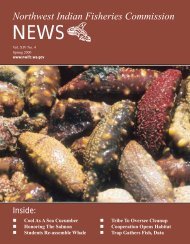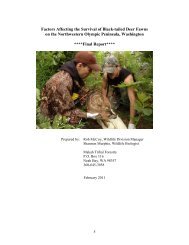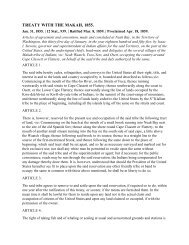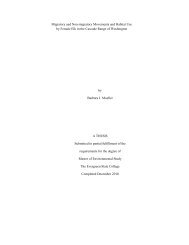DIET, NUTRITION, AND REPRODUCTIVE ... - NWIFC Access
DIET, NUTRITION, AND REPRODUCTIVE ... - NWIFC Access
DIET, NUTRITION, AND REPRODUCTIVE ... - NWIFC Access
Create successful ePaper yourself
Turn your PDF publications into a flip-book with our unique Google optimized e-Paper software.
12<br />
number of radio-collared or associated elk in the herd. All elk seen with radio-collared<br />
elk were also considered part of the same herd.<br />
When a collared elk was located by telemetry and at least one elk was observed, I<br />
recorded that location as a visually-confirmed location. For each visual location, time,<br />
location, number of animals seen, herd composition (number of cows, calves, yearling<br />
males, bulls), vegetation type (meadow, roadside, riparian, timber harvest and stand age,<br />
Appendix A), and elk activity (foraging, bedded, walking/running) were recorded. When<br />
elk were seen foraging I used 8 X 42 binoculars to observe plant species and plant part<br />
consumed (flowers, leaves, bark, twigs, entire plant) by elk (15 min to 1.5 hr<br />
observations). After elk moved away from the foraging location, I visited the exact site<br />
where the elk had been seen and recorded additional plant species present. All elk<br />
locations were determined during daylight hours.<br />
Reproductive Success<br />
Calf:cow ratios were used to quantify reproductive success of elk herds for<br />
analytical comparisons with diet and vegetation use. I determined calf:cow ratios from<br />
herd composition counts for June through December 2001. Elk cows typically give birth<br />
from mid-May to the end of June (Franklin et al. 1975). Dense spring vegetation can<br />
make seeing calves difficult, particularly when animals lay down. Therefore, I used<br />
helicopter surveys beginning in May 2001 to maximize the chance of counting all calves.<br />
Helicopter surveys occurred once a month from the last week of May 2001 through<br />
August 2001. The helicopter surveys were conducted by three observers: one observer









